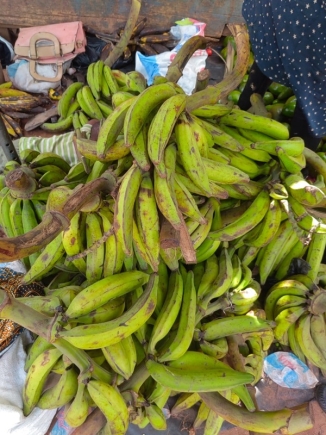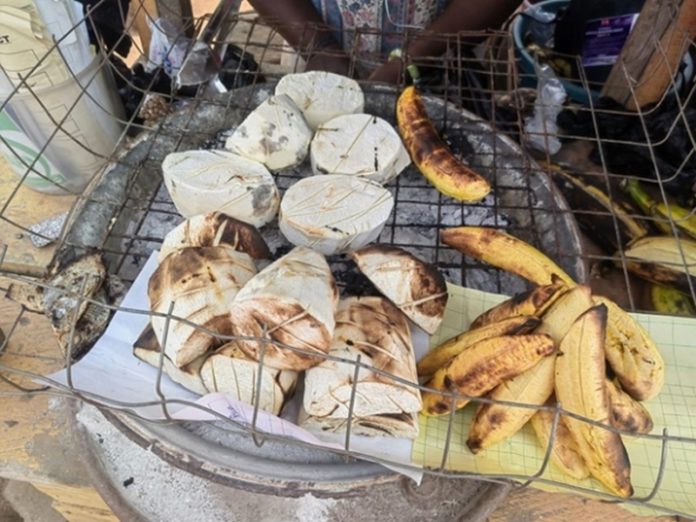‘Kofi Brokeman’, Ghana’s most popular delicacy, is no longer food for the poor even though plantain is in season, the price is being manipulated by the traders.
This is affecting various food chains that provide the basic plantain staple that many people reach for when hunger beckons.
Kofi Brokeman is roast ripe plantain accompanied by roast groundnuts. Historically, it has been the case that ‘Kofi Brokeman’ serves as a healthy, satisfying meal at little cost. Fairly recently, for example, one could buy GH₵5 worth of roasted plantain with its groundnut accompaniment and be fully satisfied.
It is the affordability and value-for-money factor that inspired the nickname Kofi Brokeman. That is, no matter how broke you were, you could afford that delicacy. The name stuck even though prominent politicians and personalities with deep pockets patronise Kofi Brokeman. And Kofi Brokeman is not exclusive to Ghana. Our Nigerian cousins call a similar concept “Boli.”
With the rise in prices, the increase in cost has defeated the Kofi Brokeman rationale and this has impacted sales. Currently, most of the women who roast this delicacy during lunch hours around the city centres, offices, churches, bus terminals, markets, schools and universities, among others, are out of business.
The few hardy ones who are still in the business sell a small slice of plantain between GH₵3 and GH₵10, something that used to be between GH₵1 and GH₵2.

The groundnuts that go with this delicacy used to be 50 pesewas but now go for GH₵2 and the quantity has also decreased.
In some places such as Spintex, Airport Residential Area, East Airport, East Legon and Adjiringanor, which have been tagged as avenues for high-income earners, the prices are even higher.
Unfortunately, Kofi Brokeman’s cousin is ‘Kelewele’ (a snack dish of fried plantains seasoned with spices) another delicacy, which is equally enjoyed by all and sundry, is equally expensive to buy. Historically, Kelewele has been something of a luxury for some because of the added cost of vegetable oils in the production process. Once the more affordable Kofi Brokeman was impacted by rising foodstuff costs, it was predictable that its more affluent cousin, Kelewele, would be impacted too. In fact, some people have stopped buying fried plantain when they buy their favourite red red or gobe (gari and beans). This is because one small piece of fried plantain is 50 Pesewas, something that used to be 20 Pesewas.
Aside from this, the price of a small sliced roasted yam has also increased from GH₵1 to GH₵5. The accompaniment of roasted koobi (salted fish) is currently between GH₵5 and ₵10 for the small size.
Market survey
A market survey by The Mirror disclosed the seriousness of the problem from a supply chain perspective. For example, though cassava is one of the common crops in Ghana and the easiest to cultivate, it is currently expensive and hard to come by. Cassava is used to prepare starch, fufu, kokonte, banku, agbeli kaaklo and gari. However, the high prices have affected such foods which are for the average Ghanaian.
A medium tuber of yam is sold between GH₵15 and GH₵20, while three medium tubers are GH₵50. Cocoyam, which is also used by others for fufu, is five pieces for GH₵20. It is for this reason that most people who are in the fried yam business are beginning to add banku to their business as a ball of banku is cheaper than tiny slices of fried yam.
For those who patronised the chop bars for fufu, you need to buy between GH₵10 to GH₵20 worth of fufu minus meat if you were to meaningfully fill your stomach.
Last weekend, this reporter went to the Mallam Atta Market, Madina, Kaneshie, Mallam, Agbogbloshie, Makola, Tema station and Texpo Spintex markets but the situation was just the same. Most foodstuffs were just expensive and all the traders were lamenting about the situation.
Vegetable
Garden eggs, kontomire and okra have all joined the expensive train. For instance, five medium-sized garden eggs are going for GH₵5, meaning one is for GH₵1, the same price that could have bought about 10 pieces in the past.
Tomatoes have equally assumed the same position making consumers wonder what food vendors are exactly cooking for people to buy.
Some people have attributed the scarcity of some foodstuffs to Ghana’s over-dependence on natural rainfall to grow food to feed its citizens in this global warming and climate change dispensation, which is a threat to food security in the country. Hikes in transportation fares are also another factor.
Some foodstuffs sellers and vendors told The Mirror that most farmers do not engage in commercial cassava and plantain cultivation simply because arable land is now prime real estate for housing development.
Madam Boatemaa Kyere, who has been selling plantain, cocoyam and kontomire at the Madina Market for the past 30 years, said most lands, which were used for farming, had been sold to estate developers, therefore, contributing immensely to the shortage of most of the major foodstuffs.
She swore that the rate at which farmlands had been consumed by real estate development was beyond anything she had seen in her lifetime.
This assertion can be true to some extent as most of the lands around the Trade Fair Site, La, Madina, Dodowa, Aburi, Lashibi, Ashaley Botwe, Kasoa and many others are all being developed by estate developers.
In the past, these were areas where some farmers grew okra, onions, tomatoes, mangoes, garden eggs, pepper and other vegetables, which made foodstuffs less expensive.
READ ALSO:
A saga of truth and lies: why the feud between Wontumi and Kokosohene is not ending
Schools closed down in Kwahu-Bepong after fatal shooting incident
Exclusive: Antoa chief priest bares it all on Wontumi-Kokosohene saga [Video]

